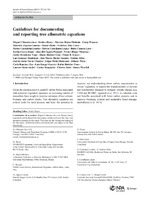Guidelines for documenting and reporting tree allometric equations

Date
2015-09Author
Cifuentes-Jara, Miguel
Matieu, Henry
Réjou-Méchain, Maxime
Wayson, Craig
Zapata-Cuartas, Mauricio
Piotto, Daniel
Alice-Guier, Federico
Castañeda-Lombis, Héctor
Castellanos-López, Edwin
Metadata
Show full item recordAbstract
Given the pressing need to quantify carbon fluxes associated with terrestrial vegetation dynamics, an increasing number of researchers have sought to improve estimates of tree volume, biomass, and carbon stocks. Tree allometric equations are critical tools for such purpose and have the potential to improve our understanding about carbon sequestration in woody vegetation, to support the implementation of policies and mechanisms designed to mitigate climate change (e.g. CDM and REDD+; Agrawal et al. 2011), to calculate costs and benefits associated with forest carbon projects, and to improve bioenergy systems and sustainable forest management (Henry et al. 2013).
Source
Annals of Forest Science (2015) 72:763–768. DOI 10.1007/s13595-014-0415-zShare
Metrics
Collections
- Artículos [37]
The following license files are associated with this item:


